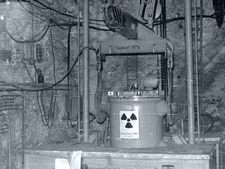1970 - 1990: Repository of the former GDR
- For monetary reasons, the former GDR examined only existing salt mines when searching for a repository site.
- The emplacement of radioactive wastes was already launched in 1971 before the repository was licensed and structural preparations were completed.
- According to today's criteria, the mine would not have been licensed as a repository.
Site selection and licensing procedure
In 1966, the Rheinsberg nuclear power plant was commissioned as the first NPP in the GDR. Concepts for the disposal of radioactive wastes did not exist at that time. The former GDR searched a site for a repository for radioactive wastes. For monetary reasons, the GDR only examined already existing salt mines.
The Bartensleben mine in Morsleben was selected in 1971 and a multi-stage procedure was initiated. Since space had become scarce in the Lohmen interim storage facility in Saxony, radioactive wastes were already emplaced in 1971 before the licence was granted. The licence for the site was granted in 1972.
In 1978, a three-year-lasting trial operation of the repository started. After the licence for fixed-term permanent operation had been granted in 1981, the licence for permanent operation was granted in 1986.
Emplacement of radioactive wastes

![]() Drum reloading prior to licencing and construction of the repository, 1972
Drum reloading prior to licencing and construction of the repository, 1972
The Soviet Union where the fuel elements originated from, took back high-level radioactive wastes. Low-level and intermediate-level radioactive wastes had to be managed by the GDR itself. The emplacement of radioactive wastes was already launched in 1971 before the repository was licensed and structural preparations were completed. Later on, solid and liquid radioactive wastes were emplaced, testing and adapting several different methods.

![]() Drum container in the dumping device, 1983
Drum container in the dumping device, 1983
Solid wastes were stacked in drums, placed without packaging or dumped from above into emplacement chambers. Liquid wastes were solidified with brown coal filter ash. Due to problems arising, the Federal Office for Nuclear Safety and Radiation Protection temporarily prohibited the procedure in 1982. The emplacement of liquid wastes ended in 1990.
| Year | Event |
|---|---|
| 1970 | Preliminary site selection |
| 1971 | Advance emplacement of radioactive wastes |
| 1972 - 1974 | Trial emplacement with mining technology |
| 1974 - 1978 | Conversion of the facilities to a repository |
| 1978 - 1981 | Trial operation of the repository |
| 1981 | Fixed-term licence for 5 years |
| 1986 | Permanent operating licence |
| 3 October 1990 | Reunification: The Federal Office for Radiation Protection became operator of the repository |
State of 2017.01.03

